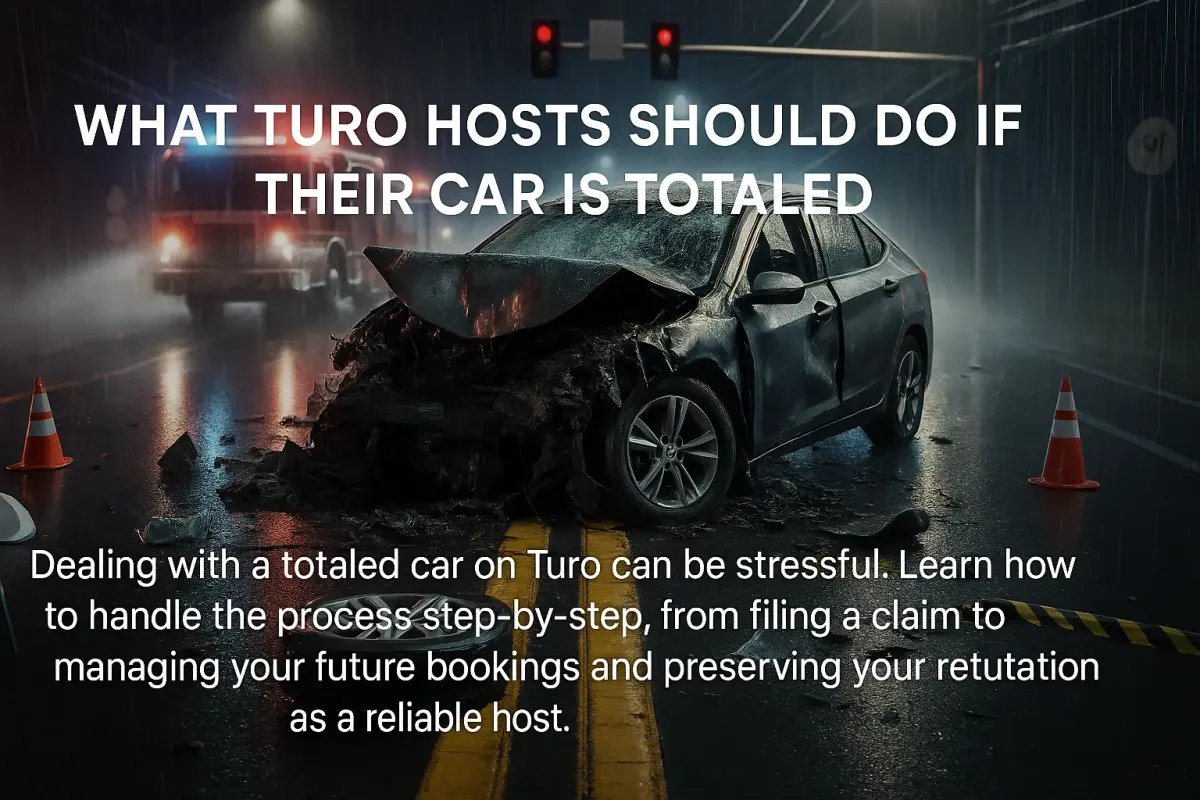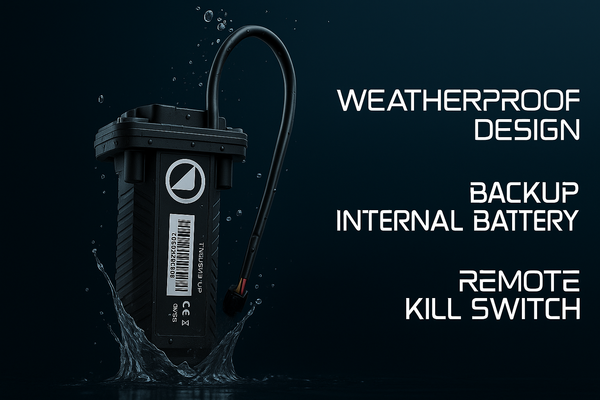What Turo Hosts Should Do If Their Car Is Totaled
Dealing with a totaled car on Turo can be stressful. Learn how to handle the process step-by-step, from filing a claim to managing your future bookings and preserving your reputation as a reliable host.

Introduction: Why Understanding the Total Loss Process Matters
Being a Turo host means offering vehicles for rent to people who trust you with their experience. However, accidents happen, and sometimes a vehicle can be totaled during a rental. If you find yourself in this unfortunate situation, it’s essential to understand the process for dealing with a total loss. Having a well structured plan and knowing how to navigate the steps can save you time, reduce potential costs, and minimize stress. More importantly, it ensures that you remain professional and efficient, which helps preserve your credibility and reputation as a host on Turo.
Why should Turo hosts care about understanding the total loss process?
- Protects Your Investment: A totaled car can represent a significant financial loss. By understanding your options, you can mitigate the effects on your investment.
- Saves Time and Cost: Prompt action and clear documentation can prevent additional costs, such as daily storage fees at a tow yard or unnecessary delays in receiving your payout.
- Maintains Credibility: Following through with the total loss process helps maintain a trustworthy reputation. Guests are more likely to return and recommend you if they see you handle incidents with professionalism.
Step 1: Inform Turo Promptly
File a Claim Immediately
The first and most critical step when your car is totaled is to file a claim with Turo immediately. As soon as the accident occurs and you’ve confirmed the vehicle is deemed a total loss, use Turo’s designated portal to report the incident. The portal allows you to submit your claim with all the necessary details, ensuring the process is officially underway. Provide as much information as possible, including photographs of the damage, any collision information, and the police report if applicable.
By filing the claim promptly, you prevent delays in processing, helping you receive a quicker resolution to your case. Even if the damages aren’t severe enough to be considered a total loss immediately, it’s always safer to start the claim process early.
Communicate with Upcoming Renters
After reporting the incident to Turo, the next step is to inform any upcoming renters. If your car has future bookings, you’ll need to contact Turo and request that they cancel or redirect these reservations. This ensures that guests aren’t inconvenienced and that your ratings remain unaffected. Being proactive and managing future bookings shows that you care about your renters' experiences, which contributes to positive feedback in the long run.
Effective communication with your renters also demonstrates a high level of professionalism. Ensure they are aware of the situation, and if necessary, offer assistance or alternatives, especially if the booking cannot be redirected or canceled.
Step 2: Gather Essential Documentation
Accident Details
Once the claim has been filed, it's time to start gathering all essential documentation. The more thorough and organized you are with your paperwork, the smoother the process will go.
Start by collecting accident details such as:
- Police reports: If the police were involved, request an official report outlining the details of the incident.
- Towing receipts: Obtain a receipt from the tow yard or service that handled your vehicle after the accident. This is a crucial part of the documentation, as it helps to track the timeline of events.
- Message exchanges: Keep a record of all communications with the renter regarding the accident. This includes text messages, emails, and any direct conversations related to the situation. These messages can be vital in case there’s any confusion about who was responsible or how the incident occurred.
Vehicle Condition
Once you've taken care of reporting the accident and gathering basic information, focus on documenting the vehicle's condition. Be sure to take clear and detailed photos of the damage. Capture shots from different angles and include close ups of the areas most affected by the accident. Photos are invaluable, as they serve as the primary visual evidence when discussing the vehicle’s condition with the insurance partner.
- Important: Make sure to document the vehicle’s condition before moving or releasing it. Once the car is moved or repaired, it can be harder to prove its original state.
- Remove personal belongings: As soon as it’s safe to do so, remove any personal items from the vehicle. This helps prevent any further issues with the storage or disposal of the vehicle and ensures there are no misunderstandings about what’s in the car.
Step 3: Address Towing and Storage
Minimize Storage Fees
If your car has been towed to a yard, storage fees can begin accumulating immediately. These fees can add up quickly, so it’s crucial to act as swiftly as possible. After the vehicle is towed, you need to arrange for its release. Work closely with Turo's claims partner or a designated salvage yard to get the vehicle moved without delay.
It’s also essential to sign any paperwork that authorizes the vehicle’s removal from the storage facility. This paperwork could include documents that release the tow yard from liability, so review them carefully before signing.
Stay in Touch with the Claims Adjuster
As you go through the towing process, stay in contact with the claims adjuster assigned to your case. Ask for updates on when the vehicle will be collected, and ensure that there’s no confusion about where the car is being taken.
- Tip: Document every day the car remains uncollected in case the storage fees become an issue. Turo’s claims team may be able to help cover some of these fees, but only if you can provide clear evidence of the delay.
Step 4: Work with Turo’s Insurance Partner
Follow Their Instructions
Once you’ve been assigned a claims adjuster, cooperate fully with them throughout the process. The adjuster will be your main point of contact for everything related to the insurance claim, so ensure you’re responsive and provide any additional documents or clarifications as requested. Their goal is to assess the vehicle's value, review the damage, and work out a fair payout.
Throughout this process, maintain clear communication with the claims adjuster. If any further information is needed, provide it promptly to keep the claim moving forward.
Evaluate the Settlement
When the claims adjuster offers you a settlement, take the time to evaluate it thoroughly. Ensure the payout reflects the market value of your vehicle, not just the estimated repair costs. You can look up similar cars in the market or get a professional appraisal to compare. If the settlement doesn’t seem fair, reach out to the claims adjuster to discuss it.
Step 5: Finalize Your Claim
Review All Paperwork
Before finalizing your claim, make sure to carefully review all documents related to the total loss. Double check that the insurance details match your coverage plan, including deductibles and any applicable salvage values. Pay close attention to the payout offer and ensure there are no unexpected fees or mistakes in the paperwork.
Manage Future Bookings
If your car is deemed beyond repair, it’s time to remove it from your Turo listing. Confirm that your car is delisted from the platform, and make sure your future renters are notified about the situation. If there are still pending reservations, try to cancel or find another vehicle for your renters to avoid disappointing them.
Best Practices for a Smoother Experience
- Keep Detailed Records: Throughout the process, maintain a record of all communication, receipts, and timelines. This ensures you have all the information you need for reference and helps prevent delays.
- Be Persistent Yet Courteous: If the claims process stalls, reach out politely but persistently to ensure things keep moving. Contact Turo support or the claims partner as needed.
- Understand Your Coverage: Know the terms of your protection plan, including your deductible and liability limits. Being well informed will help you make better decisions and avoid surprises.
Conclusion: Managing a Totaled Vehicle on Turo
Dealing with a totaled car on Turo is undoubtedly stressful, but following a structured approach will help you manage the situation effectively. By filing the claim promptly, gathering detailed documentation, working closely with Turo's insurance partner, and managing future bookings, you can resolve the situation with minimal hassle. By staying organized and maintaining clear communication, you protect your investment and ensure that your reputation as a reliable host remains intact.
Frequently Asked Questions (FAQ)
What should I do if my Turo car is damaged but not totaled?
Even if your car isn't deemed a total loss, follow the same process by reporting the damage to Turo immediately, and ensure that the car is repaired or removed from your listing as needed.
How can I minimize storage fees after my car is totaled?
Arrange for the vehicle’s release to a salvage yard or Turo’s claims partner as quickly as possible. Ensure that all paperwork is signed promptly to release the vehicle and stop the accumulation of storage fees.
Can I appeal Turo’s payout offer if I think it’s too low?
Yes, if you believe the settlement doesn’t reflect your car’s market value, you can negotiate with the claims adjuster. Be sure to provide evidence such as appraisals or comparable vehicles.
How long does it take to receive a settlement after a car is totaled?
The timeline can vary, but typically, it takes a few weeks to finalize the claim. However, if you provide all the necessary documentation promptly, the process could be quicker.





